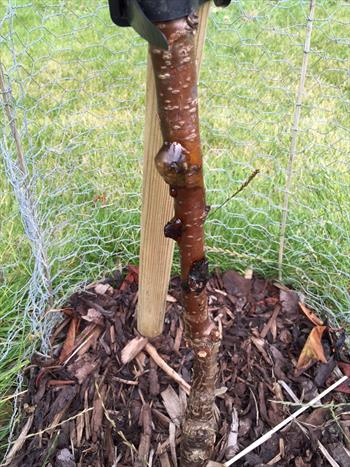 Bacterial canker on a young cherry tree
Bacterial canker on a young cherry treeBacterial canker is one of the more serious diseases of stone fruit trees, especially plums and cherries, but also peaches, necatarines and apricots. It is endemic in the UK.
Infection is most likely to occur in mild wet weather over spring and summer, and the bacteria are more active in warmer climates. Trees which are under stress (most commonly from lack of water) are particularly at risk. The bacteria gain entry either through the leaves or through damaged branches, or later in the season through the small wounds that remain at leaf fall. Over the summer the infection may not be obvious, although in more severe cases the canker will become apparent as a dead area on the bark, or dark patches exuding gum ("gumming") on the stem, or as dead holes in the leaves (known as "shot hole").
In most cases the problem will continue in successive years, becoming gradually more apparent and giving the owner time to deal with the problem.
However in some cases the rapid growth of the tree in spring, coupled with warm temperatures, can give the bacteria the upper hand, leading to severe damage to limbs or even the whole tree.
If the canker is low on the stem then the tree cannot usually be saved.
A characteristic sign of bacterial canker is oozing of gum from the stem or main shoots - although damage from animals, insects, or strimmers can also cause this. Another sign is a sudden and dramatic loss of leaf colour, which usually indicates the disease has reached a serious stage.
If the tree is lost, dig it up and dispose of it away from other trees. If you are planting a new tree in the same area it is best to dig out the old soil and replace with fresh soil.
Resistant and susceptible varieties
Bacterial canker is most likely to be an issue for growers living in areas where spring and summer weather is warm and rainfall is high. In these areas it is a good idea to choose plum and cherry varieties that have natural resistance to bacterial canker. No variety is completely immune, but resistant varieties are less likely to become infected, and when infection does occur, the progress is slower and remedial action (i.e. removal of affected limbs) is more likely to be successful.
Plum tree varieties resistant to bacterial canker.
Cherry tree varieties resistant to bacterial canker.
Treatment
Although bacterial canker is very different to the fungal canker which affects apple and pear trees, the results are similar, and the treatment is also similar. As ever the secret to success is to spot the problem early. The main technique is to cut back affected limbs to fresh wood, and as with fungal canker, it is far better to err on the side of caution - if in doubt, cut back even further.
The well-known chemical "Bordeaux mixture" can also be applied. Although this is a fungicide, it works against bacterial canker as well. It is copper-based and therefore permitted by most organic standards organisations.
